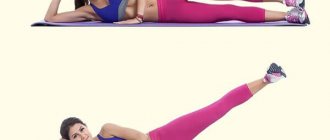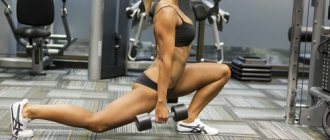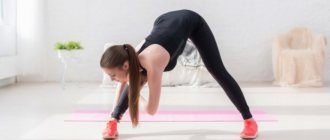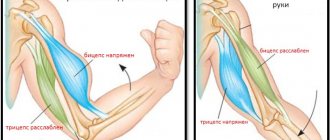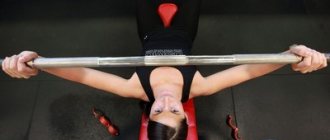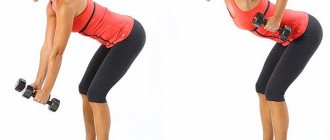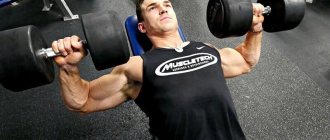Training programsFor beginners
In just 10 days, an ugly caterpillar turns into a beautiful monarch butterfly. Just imagine what you can achieve if you stick to the perfect diet and perfect workout program for a month. Now stop dreaming, it’s time to take decisive action and pump yourself up in one month!
Author:
Christopher Smith, Certified Strength and Conditioning Specialist
Actually, I was never the toughest guy in the gym. As a child, I was the smallest student in the class; at the end of school I weighed 52 kg, and that was if I was thoroughly wet. So when some guy comes up to me at the gym and complains that he's tried everything and his muscles aren't growing, I can say with 100% certainty that this is complete bullshit.
Typically, in this case, the first thing I do is ask the so-called “hard gainer” what he ate in the last two days. As I formulate the question, I’m already preparing for the inevitable story about how much he eats, but the trouble is that his metabolism is too intense. After this, we smoothly move on to his training program.
Ultimately, and this is confirmed by many years of experience, multiplied by our own experience of gaining muscle mass, we always come to the same conclusion: you don’t eat enough, you eat all sorts of crap, and your workouts suck.
No one wants to hear this addressed to them, but in 9 cases out of 10 it is all true. But instead of facing the truth, hardgainers prefer to blame heredity for their troubles. It turns out that this DNA deprives them of the ability to develop muscles. Alas, they are doomed forever, and will remain the smallest visitors to the gym.
Or maybe not. Over the years, I've learned a lesson about complaining about my metabolism. I worked hard in the gym, picking up every pound of muscle here and there. Don't get me wrong, I became much stronger, and this was my priority in training, but I still did not gain impressive volume. However, I tried a lot of things and learned which measures work and which ones are simply wasting my time.
With all that said, let's break down the three main reasons for failure listed above.
Reason 1: You're not eating enough
If you call yourself a hard gainer, I can say with 99% certainty that your diet is to blame. You're either not eating enough or you're feeding your body crap. And, most likely, both are true.
My experience is that hard gainers should get at least 3g of protein per kilogram of body weight, 4g of carbohydrates and 1g of fat
For example, in recent years, short-term fasting has become trendy among men. But if you're a skinny guy trying to gain muscle, it's not a good idea.
So instead of waxing lyrical about all the benefits of 18/6 intermittent fasting and its potential for stimulating muscle growth, save us time. It's hard - I'm not saying it's impossible, but it's very hard to gain the required amount of calories while using long fasting periods.
I understand that no one wants to count calories. Okay, but then you have to learn how to at least count macronutrients correctly. In my experience, hardgainers should get at least 3 grams of protein per kilogram of body weight, 4 grams of carbohydrates and 1 gram of fat.
Here are approximate figures that helped both my clients and me personally achieve results. They are not set in stone, but are great as a starting point. If you're unsuccessfully trying to build muscle, there's a good chance your diet isn't providing you with the nutrients mentioned above.
Which brings us to the second part of the conversation about why dieting may be hindering your progress:
How to pump up girls very quickly for summer
For girls, the priority is the gluteal muscles, legs and abs. Don't forget about your back and pectoral muscles as well.
For the gluteal muscles and thighs, use the classic squat, lunges with dumbbells, and Romanian deadlifts. You can add moving your legs back while standing on all fours and lifting your pelvis while lying on your back.
For your back, use exercise machines: gravitron and block exercise machine. The Gravitron makes pull-ups easier - objectively the best exercise for the back. On a pulley machine, perform overhead and horizontal rows. If your physical fitness does not allow you to perform any of these exercises, then do bent-over dumbbell rows.
Reason 2. You eat low-quality foods
One of the problems with processed foods—that is, low-quality foods—is that even when they contain meat (like hot dogs or hamburgers), they are a surprisingly poor source of protein. Things are a little better with carbohydrates and fats, but only to a certain extent - in the end, it's all food waste.
In short, if you're trying this hard, when you get to oh, ask yourself if you're really getting enough protein. Probably not. But the protein norm mentioned above, 3 grams per kilogram, refers to days without training.
On training days, with the addition of pre- and post-workout nutrition, this amount should be close to 4 grams per kilogram. This is quite easy to do by using quality whole foods as a source of protein, which includes whole meat and milk, but not junk food.
If you're actually getting enough protein, but you're still not gaining muscle mass, then you need to pay attention to carbohydrates. Surprisingly, especially considering the diet of the average American, this is where many fail. We've been told so often to focus on protein that we've completely forgotten the importance of carbohydrates. The widespread condemnation of carbohydrate-rich foods only makes the situation worse. Meanwhile, a balanced intake of carbohydrates not only fuels your workouts, but also replenishes glycogen stores, which turns on the green light for muscle growth.
After you have adjusted your carbohydrate and protein intake, check whether the amount of fat in your diet meets your needs. Fats in food are very important for the endocrine system, and it is very difficult to build muscle if there is no more testosterone in the body than a teenage girl.
Exercises for training without iron
- Push-ups (and all kinds of variations);
- Pull-ups (and all kinds of variations);
- Horizontal pull-ups;
- Reverse push-ups;
- Headstand push-ups;
- Biceps curl;
- Bodyweight triceps exercise;
- Lunges (and all kinds of variations);
- Squats;
- Bulgarian squats;
- Pistol squats;
- Lying leg curl;
- Romanian deadlift on one leg;
- etc.
This is by no means a complete list of exercises. You'll find a bunch more.
But this is enough to create one of your workouts. There are enough exercises in this list to make working out at home truly effective for building muscle. And it will be without any additional equipment and without exercise equipment or going to an expensive gym.
Add, for example, a resistance band, and now you can do dozens of other exercises (close-grip rows, presses with a band, swings of arms forward and to the sides, biceps and triceps exercises, etc.) ...
So, the more exercise, the better. This is good news. Now for the less good news...
How to pump yourself up at home using dumbbells, kettlebells and other sports equipment does not raise any questions. It is much more difficult to competently create a training program from exercises that do not involve the use of weights.
Squats
Squats work the muscles in your lower body. With their help, you can increase the endurance of the leg muscles, as well as give relief to the buttocks and back of the thigh.
In addition, squats:
- improves posture;
- practices coordination;
- trains the cardiovascular system;
- increases the overall endurance of the body.
The main advantage of this type of load is the fact that there are a minimum number of contraindications for its implementation. With the help of a well-chosen squat technique, doctors recommend that professional athletes recover from injuries in this way.
The classic technique of performing squats involves strict adherence to the algorithm:
- Stand up straight; place your feet at shoulder distance; straighten the spine; stretch your neck; Place straight arms along the body.
- Take a deep breath through your nose and bend your lower limbs at the knee joints, thus bringing your buttocks closer to the floor.
- While at the lowest point, you need to make sure that your knees are approximately at the level of your big toes, but do not go beyond your feet. Bring your arms forward without bending them.
- After holding for 3-5 seconds, exhale sharply, allowing the air to escape through the mouth, and slowly take the starting position while standing on straight legs.
Push ups
With push-ups, you can not only strengthen your upper body, but also work your abs and back muscles. Thanks to the many variations of this exercise, its regular inclusion in the training program will allow you to work out the maximum number of muscle groups of the athlete, without loading the cardiovascular system.
In order not to put the body into a state of shock from excessive load, professional fitness trainers recommend starting to do push-ups on your knees, gradually moving on to the classic exercise:
- Take a horizontal position, stomach down; place your palms in the chest area, resting their backs on the floor; Place your feet on your toes.
- Straighten your arms and thus lift your stomach from the supporting surface; pull in the stomach; knees should be straight.
- Inhale deeply and, as you exhale, lower yourself as close to the floor as possible by bending your arm at the elbow joint.
- Having touched the floor with your chest, return to the original position, while controlling that the body changes its position, being in a consistently straight state.
Reverse push-ups
It is not recommended to perform this exercise while leaning on a sofa or chair. This can cause loss of balance, improper load distribution and, as a result, injury to the athlete (sprain, rupture, etc.).
It is recommended to perform reverse push-ups at home, following the basic recommendations of professionals:
- Turn your back to the supporting surface, which should be at the level of the person’s hips when he is in a standing position.
- Place your palms on the support so that your fingers are turned toward your back.
- Bend your legs at the knees and place them on your feet, forming a right angle at the knee joint.
- As you exhale, bend your elbows and bring your buttocks as close to the floor as possible.
- Without pausing, slowly straighten your arms, thus raising your body to its original position.
At the top point, it is not recommended to fully straighten your arms, as this can lead to damage to the elbow joint (its dislocation, protrusion, and even crack).
Lunges
With the help of lunges, athletes can work the back of the thigh and buttocks at home. Despite the high effectiveness of the exercise in question, it has a high risk of injury.
It is necessary to strictly follow the technique of its implementation:
- Stand up straight; place your feet shoulder-width apart; straighten your back; put your hands on your belt.
- After taking a deep breath through the nose, allow the collected air to leave the lungs through the mouth; put your left leg forward; bend the lower limbs at the knees so that the right leg touches the floor while the body is in the lower position. It is not recommended to concentrate most of the weight on one of the legs; body weight should be distributed between both limbs.
- After holding for 2-3 seconds, slowly straighten your legs and return to the starting position, placing your left limb in place.
- Repeat step 2, replacing the left leg with the right.
As the athlete performs lunges, she may feel a lack of actual load. In this case, fitness trainers recommend resorting to the use of improvised weights. Their role can be played by books, bottles of water or bags with things of the same mass.
Plank
Due to the distribution of the load throughout the muscles when performing the exercise, the time spent in the rack must be increased gradually, starting from 20 seconds. The optimal increase in load is to add 10 seconds. during each lesson, starting from the third.
- Position your body in a horizontal position, resting on the floor on your elbows and tips of your toes.
- Pull in your stomach; make sure that there is no deflection in the lumbar region, and that the muscles of the whole body are as tense as possible.
- Lower your face down, creating a straight line passing through your legs, torso, neck and head.
- Maintain the body in this position for the required amount of time, without relaxing the muscles or changing position.
When in the plank position, it is recommended to maintain measured breathing, making sure that the inhaled air does not linger inside the lungs. Otherwise, the athlete may feel dizzy or nauseous due to lack of oxygen in the body.
Side plank
You can pump yourself up at home both by performing dynamic exercises and by practicing static exercises. The side plank is considered the most effective static load that can rid a person of excess fat in the waist and sides. With its help, you can also work out your abs, making them more prominent and strong.
The rack in question will be most effective when performed in combination with the classic version of the plank. Due to the multidirectional load, the body does not become overtired, and the muscles work due to the acceleration of blood circulation in the areas of the body being worked.
- Lie on your left side, resting your hand on the floor on your elbow and the side of your left foot; place your right foot on top of your left.
- By tensing the muscles of the body, lift yourself up on your left arm, making sure that the weight is distributed evenly between the two points of support.
- Place your right hand along your body; pull in the stomach; Tighten your buttocks.
- After spending the required amount of time in this position, turn over to the other side and repeat similar actions while lying on your right side.
Superman
Using the “Superman” exercise at home, you can strengthen your back muscles, and especially the thoracic and lumbar spine. The simple technique of its implementation allows you to include such a load in training programs for people of any age, body size and health status.
- Lie on your stomach; stretch your legs and arms down and up, respectively; point your face towards the floor.
- Inhale deeply and, as you exhale, lift your limbs off the floor, forming a bend in the lower back due to the tension of the back and abdominal muscles. Raise your head, looking forward.
- Fix the position for 10-15 seconds, then slowly return to the original position, avoiding sudden movements and rapid muscle relaxation.
Correct execution of this exercise will help avoid exacerbation of osteochondrosis (if present), improve posture and minimize the risk of a person developing spinal curvature.
Crunches with leg raises are included in the home workout program to work the muscles of the upper and lower abs. When performing this exercise, you must ensure that your lower back is always pressed to the floor. Otherwise, the athlete risks getting a sprain or causing a vertebra to be knocked out of the spinal column.
- Lie on your back; put your hands behind your head; stretch your legs.
- As you exhale, raise your upper body (to the shoulder blades), at the same time bend your knees, as if pressing your lower limbs towards you.
- Without pausing, return to the starting position, avoiding jerks and other sudden movements.
Reason 2 (a). Your training nutrition is no good
Timing your pre- and post-workout nutrients is especially important if you're trying to gain muscle mass. You're already drinking a post-workout protein shake, which is great, but what about pre-workout nutrition?
The Best Pre-Workout Supplements for Mass Gain
BSN NO Xplode 2.0
A pre-workout supplement that increases strength and endurance and accelerates the growth of lean muscle mass.
Muscle Pharm Assault
Pre-workout complex. Increases strength and endurance and speeds up recovery!
Dymatize Xpand 2x
Increases peak strength and improves athletic performance! Muscle detonator in a pre-workout formula!
Universal Nutrition Animal Rage
Pre-workout complex. A source of incredible strength and performance!
Including a pre-workout shake is important for two reasons. Firstly, it increases the amount of calories and protein in the daily diet, and this is highly welcome when it comes to gaining weight. Secondly, it charges your body with amino acids and carbohydrates that will be needed for the upcoming workout. I've found that for many, simply adding a pre-workout to their diet has been a welcome turning point.
Intra-training nutrition, that is, nutrition during training, is another often overlooked element that has helped many to spur muscle growth. Rest assured, sipping on amino acids during your training session will be great for recovery, but it can also impact muscle growth. And every desperate hardgainer should wrap their heads around this!
A pre-workout shake increases the amount of calories and protein in your daily diet.
And, of course, after training you should give your body protein. Not only a cocktail, but also normal food. And that's it!
How to increase the productivity of training sessions?
Now you know how to pump up your abs in a week or a couple of weeks. But the effectiveness of exercises can be significantly increased if:
- Eat properly. You shouldn’t forget about sweets, since glucose is extremely necessary for the brain and muscle mass. But it’s better to forget about fried potatoes, fatty meat, and rolls. Their place in your diet should be taken by eggs, cottage cheese, all kinds of fruits and vegetables.
- Drink plenty. Without a sufficient amount of fluid, normal metabolism is impossible. Increased fluid intake will promote rapid fat loss. You should drink 1.5 liters throughout the day. water.
- Do stretching at the end of the main complex. It helps increase muscle flexibility. It is especially appropriate for well-warmed muscles. Get on your knees and lean further forward. Take your time. Using your knees, make a bridge. Failed? No problem - 2 days and everything will work out.
Now you know how you can quickly pump up your abs in a week. Follow the tips, and in a short period of time you will be able to amaze everyone with the look of pumped up, beautiful abs on your stomach, as in the photo. A detailed lesson is presented in the video.
Reason 3: Your workout program sucks!
I don't know what guys get more offended by - being told that their diet sucks, or when it comes to training. I think it's about the same.
Hey, no one wants to admit they're doing something wrong. And this is normal, especially when it comes to men. But if your workouts aren't working, you have to admit that they might not be effective enough. The training puzzle consists of many pieces, each of which may be out of place, but we will focus on the three main mistakes.
Lousy selection of exercises
If, when you cross the threshold of the gym, you immediately rush to straighten your arms in a triceps bend, and then go to sit up on your toes, then you are doing everything wrong. Exercise selection is the most important aspect of strength training. By choosing unsuccessful exercises, you doom yourself to lack of results. The vast majority of exercises in your training program should be multi-joint compound movements such as squats, various variations of deadlifts, standing overhead presses, bench presses, pull-ups and rows.
Most of the exercises in the training program should be represented by multi-joint basic movements.
I created entire programs in which I used nothing but these movements. In the program below (yes, there will be a program! I'm not just here to pick on you) you will find tips on how to choose effective exercises. Notice how many basic movements there are and how few isolation exercises there are.
Constant number of repetitions
Varying the number of repetitions is perhaps the basis of creating a training program. Your body adapts quite quickly to a certain number of reps, so if you've been doing 3 to 10 reps for years, that could be one of the reasons why you're not getting results.
An effective program requires the use of differentiated numbers of repetitions to develop different strength qualities and work all muscle fibers. In the meantime, we are talking about the number of approaches...
You are using the wrong amount of load
Training load volume is the number of approaches and repetitions for each exercise.
If the volume is too small, there is no need to talk about the result. If you overdo it, you won’t have time to recover, or worse, you’ll get damaged. Let's say you vary the number of repetitions - you do vary, right? In this case, you should also change the number of approaches you perform in order to spur adaptation processes. Options for number of sets and reps for hypertrophy
4 Sets x 8 Reps 5 Sets x 5 Reps 4 Sets x 10 Reps 4 Sets x 6 Reps 3 Sets x 12 Reps 7 Sets x 3 Reps
Let's think about it this way: if you do 3 sets of 4 repetitions, the total number of repetitions in the exercise is 12. Do you think you can build muscle with just 12 repetitions? Never mind! But if you make 6 by 4, you'll get closer to the end zone.
The golden rule is that by performing somewhere between 25-40 repetitions, you enter the muscle growth zone that allows you to pump up in a month. Of course, this is not an ironclad rule: you can go down to 15 or go up to 50. However, it is the area between 25 and 40 repetitions that is considered the “golden mean”.
As you can see, you have plenty of wiggle room, which means there are plenty of ways to develop muscle in the gym.
Pump up on the horizontal bar? Reality or myth?
People who do not have access to a gym ask how to grow muscles on the uneven bars and horizontal bar. It is impossible to get pumped up in 3 months using an outdoor sports ground, but you can significantly improve your physical fitness.
- Look at gymnasts - they all have pronounced muscle definition. But all this is connected with a special type of training. When performing more than 12 repetitions of one exercise, endurance develops: that is, a hundred push-ups simply indicates the effectiveness of their implementation.
- Long-distance runners do not have muscle definition like sprinters - they need explosive work. On the horizontal bar, this can be achieved using kipping pull-ups, which is practiced in CrossFit. However, exercises with your own body weight must either be complicated or combined with weight lifting - powerlifting.
To begin with, you can do push-ups with your feet elevated, Hindu or bomber push-ups, jumping or clapping push-ups. Then do push-ups in a corner position or in a handstand. On the horizontal bar, progression is achievable with the help of weights - a belt with a weight of 5-10 kg or more or a backpack with any weight. In a similar way, you can load the triceps on the uneven bars. However, it is impossible to work your legs and buttocks on the horizontal bar.
We wish you productive training and sculpted muscles!
Last approach
In conclusion, I would like to focus on the last approach. As a general rule, I advocate avoiding rejection for as long as possible. Working too often to failure is a sure way to lower results. However, a well-planned push to the limit can be one of the best things you can do in the gym.
In this program, I recommend that the last set of most exercises, especially the main exercises, be performed to technical failure. This means that you cannot perform another repetition on your own with proper form. In other words, if you need a spotter - even if he just hooks his fingers under the bar - it's time to stop. You won't be able to complete a single rep without help.
With proper nutrition, everyone can gain 2-2.5 kg in a month, and there is no reason to doubt it. Be sure to monitor your body weight for 4 weeks. If you are not moving in the right direction, change your diet. You don't need to count calories, but you should definitely have an accurate idea of what you're consuming.
Is it possible to pump up at home? Yes! But…
The good news is that the answer to this question is definitely yes.
You can train at home and still build muscle without the special machines found in gyms. The lack of free weights certainly doesn't help, but even with these conditions... you can achieve certain results. The bad news is that it will be much more uncomfortable, much more difficult in the athletic aspect, and just much more difficult in general. That's why …
Main stages of progressive growth
Preparatory. Your body, under the weight of the weights that you offer it, prepares for hypertrophy. This period takes the first 2-3 months. The key point is, don't give up, don't quit training. Strength performance is very important in the future. Today you bench press 60 kg, “tomorrow” - 80 kg. Great, we have a start.
Basic. The longest, maximum period. Here, not a single professional trainer will answer how long hypertrophy will take. Based on the research conducted, on average, the main stage takes two to three years. Let's return to the bench press, after two years, without pharmacology, the athlete is able to raise his figure from 60 kg to 100 kg. This bar is an indicator of how quickly you can pump up.
Final – systemic muscle adaptation
We pay attention to internal circulation, heart function, and energy resources. Correctly preserve, maintain and increase, if necessary, muscle performance
This stage belongs to the professional side of bodybuilding.
As you can see, it is impossible to get pumped up in just four or five months. Don't believe the promotions, and woe to the trainers. Dear athletes and beginners, after going through the lines of my article today, you have a general idea of the process of quickly building a beautiful, athletic figure, now you know what you need to start from in order to quickly and efficiently pump up. Two years or three of fruitful work in the gym and at home. Share your opinion, comment, subscribe to updates. Best regards, Sergei.
